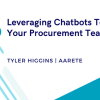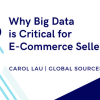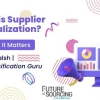Artificial Intelligence (AI), is a much used and abused term, potentially at the top of its hype cycle. In one of her recent speeches Theresa May identified AI as a major growth area for British businesses and Juniper research estimated that AI will save businesses $8 billion a year by 2020. AI is predicted to disrupt business and procurement over the next five years through the use of robotic process automation, machine learning and cognitive procurement.
So, will AI help us or will it destroy us? We don’t need to look very far for prophets of doom predicting the end of mankind because AI has decided that the best way of optimising resources is to get rid of wasteful humans. Alternatively, AI will help as an enabler tackling mundane tasks, freeing up time for people to do the things they do best. Humans will undertake the creative tasks like strategic planning and AI handles the number crunching and data analysis. This is deemed to be AI’s biggest potential application – cutting the time that people spend on complex repetitive tasks.
This has been a long time coming. In 1960, the computer scientist known as J.C.R. Licklider wrote a paper called "Man-Computer Symbiosis," which explained how humans and computers could work together in partnership and enhance human problem solving. Humans would set the goals, supply the motivation and ask the questions, and the computers would test models against the data and answer questions. Now, almost 60 years later, we can see some of these predictions beginning to bear fruit with a more balanced perspective on what AI will achieve for us, chatbots being a good example. A Gartner survey asking what organisations were planning to use AI for showed the biggest areas were smart advisors and assistants, and the survey predicted that this year 20% of smartphone interactions will be through a virtual assistant.
After the top of the hype cycle comes disillusionment - there is so much promise, but the reality is falling short. 2019 is the year that the original Blade Runner film is set – so where are our flying cars? The best we seem to have is flying drones that we can’t prevent closing down airports. So, in the immediate future we need to use AI for what AI is good at, to have a collaborative approach and complement people to free them up from chores, so they can focus on the key issues. We do have machine learning where a computer is programmed with lots of data patterns so that it can match that arrangement elsewhere. Pattern recognition AI is now more skilled at recognising skin cancer than leading dermatologists. The biggest impact of AI is unlikely to be destroying jobs but more likely changing what we do in our existing jobs with expectations that AI will be wide ranging but will not replace people. The success of Google’s Deep Mind at defeating the human world champion at ‘Go’ demonstrates the progress made in self-teaching programmes. But very few jobs can be fully automated. Having built a technology that can speak to customers or interact with colleagues we could envision a future of unaided automation. However, the reality will be that actual people will be needed to refine the products and put just as much effort into the task.
Focusing closer to home, just how is AI expected to disrupt procurement? The purpose of procurement within organisations is to fulfil the internal users’ requirements at the best value and procurement departments look to technology to help with this. Before jumping on the AI bandwagon to make sense of unstructured data, make sure that you have dealt well with your structured data first, the best of which is, of course, your spend data. Most organisations are still using legacy systems for analysis and Excel sheets keep many procurement functions alive and kicking. Much progress can be achieved using Business Intelligence (BI) tools to analyse spend data. BI is often included within the remit of AI because AI is a much more exciting buzzword. Big data is all very well, but what is needed is insight - marrying data and creativity. Data is junk unless it is analysed properly to gain insights by applying BI and AI tools to observe, learn and optimise outcomes. A good example of an AI technique is ‘Bayesian Inference,’ a statistical technique to update a hypothesis as more data becomes available.
But, as a recent report from A.T. Kearney makes plain, the procurement technology that people currently use at work is constrained and inadequate. We know what ‘good’ looks like – the most usual description being given is Amazon. But day after day, users go to their jobs and must put up with rigid ill-thought through systems that don’t serve their needs. This is because the existing technology and best practice advice has favored suppliers of technology providing services across the complete source-to-pay range of solutions. What we have ended up with is ‘Jacks of all trade and masters of none.’ The future could be different because of the development in cloud computing technology that allows small discrete applications to interconnect with each other without the need for specialist programming. Once these interconnections become easy enough for organisations to embrace fully, it is feasible for them to choose the best procurement technology for each task and intelligently plug them together, making use of an AI dashboard interface. A potential future route map would see the large-vendor solutions co-existing alongside specialist apps and the complete system evolving through technology improvements to favour the specialists.
When it comes to implementing AI technology, organisations will need to take on board some recent learnings. For machine learning it would be best best to avoid the mistake that Amazon made when it had to dump an automated recruitment system that was found to discriminate against women because most of the curricula vitarum (CVs) it learnt on came from men. And people may have genuine issues with the way a new technology functions. Google had not foreseen the backlash it received when it went out to market with Duplex, its virtual assistant that makes phone calls on behalf of the user. Duplex’s phone manner was so human-like that there were reports of people being “horrified” at the “deliberate deception” and calls for the need to flag up computer simulations, with Google expected to modify Duplex to make it less creepy.
Once we have better AI-enhanced procurement technology, or ‘cognitive procurement,’ what could that mean for the business? We could have users with requirements flowing through automated buying with chatbots fulfilling the Frequently Asked Questions (FAQs) function. Suppliers with invoice enquiries could similarly have their own chatbot, which may still not actually pay them but could at least tell them that their invoice was correctly matched and in the payment queue. The procurement staff will need different skills because they will be interfacing with a number of AI inputs and they will need to assess the information feeds and the automated recommendations and then make a judgement. Market analysis systems could provide category knowledge insight for procurement plans and risk assessments on potential suppliers. "Supplier Discovery" AI could enable you to get an extra fifteen percent savings on your average tender by adding two extra bidding suppliers. Process automation could operate in the creation of the tender event and compilation of specifications, and for e-auctions a chatbot could test drive the invited suppliers through the selected auction methodology.
In negotiations with indirect suppliers you might have complete transparency of total spend with different cuts by time period, business division, operational budget holders and geography at the touch of a button. Negotiating with direct suppliers could be facilitated by margin analysis so you could investigate profitability by product line, category, or supplier, again at a touch of the mouse. For contracted suppliers your AI might provide risk monitoring using syntax parsing to analyse natural language text into logical components and discover and flag up linkages between events that can point out hidden connections. With better supply risk intelligence, your supply base could be expanded, going against the usual reduction trends. Last but not least, businesses could protect themselves from internal organisational fraud. AI could look at transactional data to detect vendor fraud schemes which could for example involve shell companies.
The scope for using AI technology for improvement is vast and is already being implemented in ways we don’t always notice. As the science fiction writer William Gibson said, “The future is already here, it’s just not very evenly distributed.”
Region:









